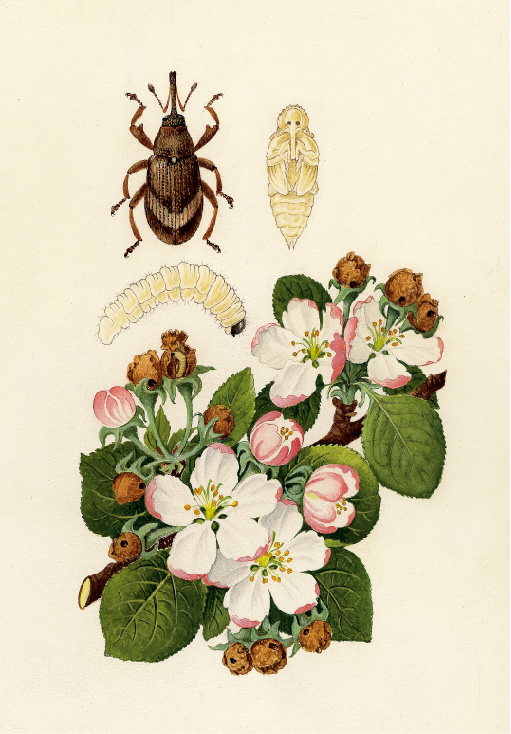Apple blossom weevil
Anthonomus pomorum
Appearance
The apple blossom weevil belongs to the weevils (Curculionidae) and is about 4 mm long and 2 mm wide. It is blackish brown in color and has a light V-shaped transverse band on the elytra.
The larvae are yellowish-white in color, slightly curved, legless and grow up to 6 mm in size.

Biology
The apple blossom weevil overwinters as an adult beetle under bark and other tree hiding places, or on forest trees and in the soil. On sunny March days, it flies to the apple trees and first carries out a ripening feeding. This is done by drilling into the swelling buds and ingesting the sap flowing from the wound. After mating, the female feeds on the still tightly closed buds and lays an egg inside. A few days later, a larva hatches and feeds on the inner flower organs and the insides of the petals, preventing the flower from opening. After feeding for three to four weeks, the larvae metamorphose into a pupa within the bud. After a short pupal rest, the young beetles then leave the destroyed flower. They then continue to feed on the underside of leaves for about two to three weeks until they seek winter hiding places from August/September. The apple blossom weevil produces one generation per year.
Damage symptoms
From mid-March, small holes can be seen on the buds caused by the ripening feeding of the beetles, and towards the end of March the damage is particularly extensive. Towards the end of apple blossoming, the infested buds are not open, but closed in a dome shape. The petals are discolored reddish brown, look like they have been burned, and eventually dry up. The interior of the flower is eroded, anthers and pistils are missing. The yellowish-white legless larva is usually found in the damaged flowers, later a yellowish pupa.
Economic importance
The apple blossom weevil appears from bud swell, especially near forests, and can cause great damage to apple trees. When environmental conditions are favorable for the beetle (years with cold spring weather that inhibits vegetation), much of the blossom set can fall victim to the pest. Toward the end of March, damage from the beetles' ripening feeding is particularly severe, especially when flower set is low. Damage threshold: 10 to 15 feeding sites per 100 flower buds (determined by visual inspection).
Prevention and control
Orchards near forests are particularly at risk. Visual inspections, such as observation of feeding marks on flower buds and tapping samples (tapping branches onto a light-colored support or into a collection funnel), can determine the occurrence of the beetles and thus the necessity and timing of any treatment. Normally, if the flower set is good, no major damage should occur and therefore the use of plant protection products should not be necessary; if it is, then treatments should be carried out before flowering (bud break to green bud stage) with a plant protection product registered for this purpose (see list of plant protection products approved in Austria).
Last updated: 03.10.2025
automatically translated